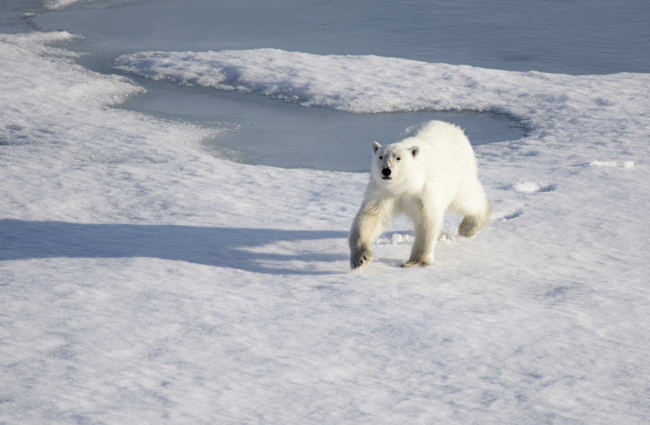
For Halloween in 2014, the kids in the village of Arviat in the Canadian Arctic had to trick-or-treat indoors. In the community center, they had a warm place to show off their costumes, but more importantly, they were safe from three polar bears outside.
That night a polar bear and her two yearlings spent three hours on the outskirts of town trying to find a way in.
The polar bear patrol used four wheelers and bright lights to try to keep the bears from getting too close to town.
Elisabeth Kruger with the World Wildlife Fund was there that night.
“The bears would go a bit on the ice and they would just wait for the four wheelers to go away and then they’d come back on shore and try to cause trouble,” Kruger said.
Jim Wilder, the polar bear project leader for the U.S. Fish and Wildlife Service in Anchorage, recently published a paper on how climate change is impacting polar bear behavior.
“When they have less opportunity to hunt, obviously that has impacts to their body condition – so the bears become thinner, skinnier,” he said. “What our study has shown actually is that when polar bears become thinner and skinnier they become a little more aggressive in their pursuit of feeding opportunities.”
The study is the first of its kind, combining research from the United States, Norway, Canada, Greenland and Russia to look at what motivates polar bears to attack humans.
Polar bears usually hunt on the sea ice, stalking unsuspecting seals. But when there’s open water where there used to be ice, the bears are forced onto land. Wilder’s study found when bears are thinner and desperate, they also become more aggressive hunters.
For evidence of this, the paper points to the worst years on record for polar bear attacks: 2010 – 2014, a period of historically low summer sea ice.
“Bears in general, particularly polar bears, make their living by investigating anomalies on the landscape. Something that might indicate there’s something there to eat,” Wilder said.
That used to mean places in the ice that indicated there were seals, but now small coastal communities on the flat tundra landscape can also look attractive to the bears.
Wilder says not to panic — there have only been six recorded polar bear attacks in the last 145 years in Alaska. But, there’s still cause for concern.
“If I lived in a coastal community,” he said. “I would be concerned about the loss of sea ice and the impact of that to polar bears.”
A majority of bears that attacked people were malnourished.
Part of Elisabeth Kruger’s job is advising small communities on the best way to keep polar bears out of town.
“One thing I hear really often in the villages is people saying ‘we’ve been here for a millennia and we’re a pretty resilient people and we’ll get through this’,” she said. “I’ve seen how people live and I don’t doubt that they will get through it. That said, this is something we haven’t seen before and it is going to cause drastic changes no matter what we do.”
In order to prepare for increased interactions between polar bears and humans, Wilder’s study mentions Arctic residents should learn to recognize malnourished bears, manage their trash properly and – if it comes down to it – know how to use a firearm.
